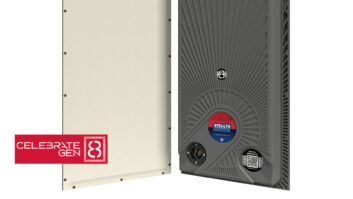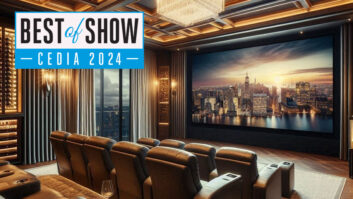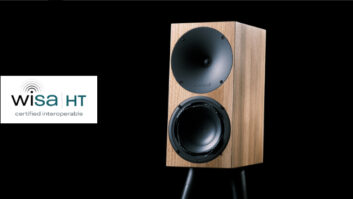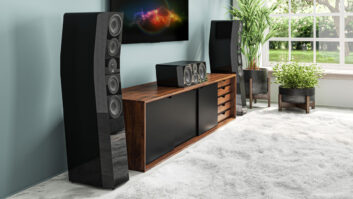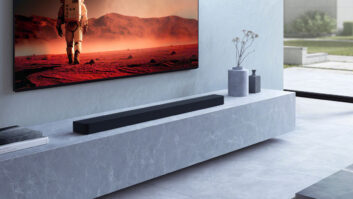Bang & Olufsen revealed prices and details of the audio industry’s first three wireless speakers certified by the WiSA (Wireless Speaker and Audio) Association.

B&O America president Zean Nielsen with WiSA-certified wireless speakers (from left) BeoLab 18 tower, BeoLab 19 powered subwoofer and BeoLab 17 compact speaker.
Additional companies are expected to launch their first WiSA-certified products at January’s International CES.
WiSA technology is promoted as delivering interference-free, wired-quality wireless audio in the 5.2-5.8GHz U-NII band to stereo and home-theater speakers within a room up to 29.5 feet by 29.5 feet.
B&O’s three active WiSA-certified speakers are the compact two-way aluminum BeoLab 17 at $3,990/pair, the 12-sided BeoLab 19 subwoofer at $3,395, and the $6,590/pair BeoLab 18. The latter speaker features narrow, cylindrical extruded-aluminum enclosure with a high-heel-shaped pedestal that appears to balance the speaker on a flat, square base. It can also be wall-mounted.
The BeoLab 18 updates the iconic design of the BeoLab 8000 speaker, a tall and narrow floorstanding speaker introduced in 1992 with pencil-point pedestal resting on a flat base.
Besides the new-style base, the BeoLab 18 also adds a top-mounted acoustic lens tweeter, which delivers 180-degree high-frequency sound to widen the stereo sweet spot, and a front grille consisting of narrow horizontal slats arrayed in a way that maintains the speaker’s cylindrical shape. The composite-material slats are available in black or white, and an optional natural-color solid-oak oak grille is available at an extra $1,350/pair.
The BeoLab 18 twists on its base to direct sound to listeners.
The BeoLab 18 and 19 will arrive in B&O-brand stores in mid to late November in the U.S. The BeoLab 17 began arriving in stores today, said B&O America president Zean Nielsen.

B&O CEO Tue Mantoni with the WiSA-certified BeoLab 18 tower and BeoLab 17 compact speaker.
Since Oct. 5, the company has been shipping its three BeoVision 11 TVs with an embedded WiSA wireless transmitter to send surround sound directly from the TVs to up seven WiSA-certified speakers and a subwoofer.
To connect the speakers to older BeoVision 11 TVs, other B&O TVs, and home-theater audio components, an outboard WiSA-certified wireless transmitter began arriving today in B&O stores.
All new B&O TVs introduced in the future will incorporate a WiSA transmitter, Nielsen told TWICE.
The B&O products bear the WiSA logo but will be promoted under B&O’s Immaculate Wireless Sound name and herringbone-like logo.
Besides delivering up to 7.1 channels of 24-bit/96kHz uncompressed audio, WiSA technology is also promoted as eliminating cable clutter, enabling more flexible placement of speakers by eliminating speaker-cable runs, and overcoming the sound quality, interference, latency and cost challenges associated with other wireless technologies designed for multichannel home theaters.
B&O’s implementation delivers 24-bit, 48kHz audio over wireless because it is less prone to interference with the lower throughputs, B&O said. The sound quality is nonetheless better than CD, the company noted.
To promote the products, the company will launch an advertising and direct-mail campaign soon after January’s CES, Nielsen said. The company is currently focusing on public relations and training, he said.
In a separate campaign, the company is teaming up with musicians, filmmakers and other audio-industry opinion leaders as part of a series of Livingroom Tour events that promote the brand as a whole. In the first event, Paul McCartney met with about 100 fans and B&O consumers to talk about music and sound without endorsing B&O products. The event was also live streamed to 200,000 people worldwide, and the 45-minute session, which included Q&A with off-site viewers, was also recorded for later streaming.
To continue reading this story, click here to visit TWICE.com.

